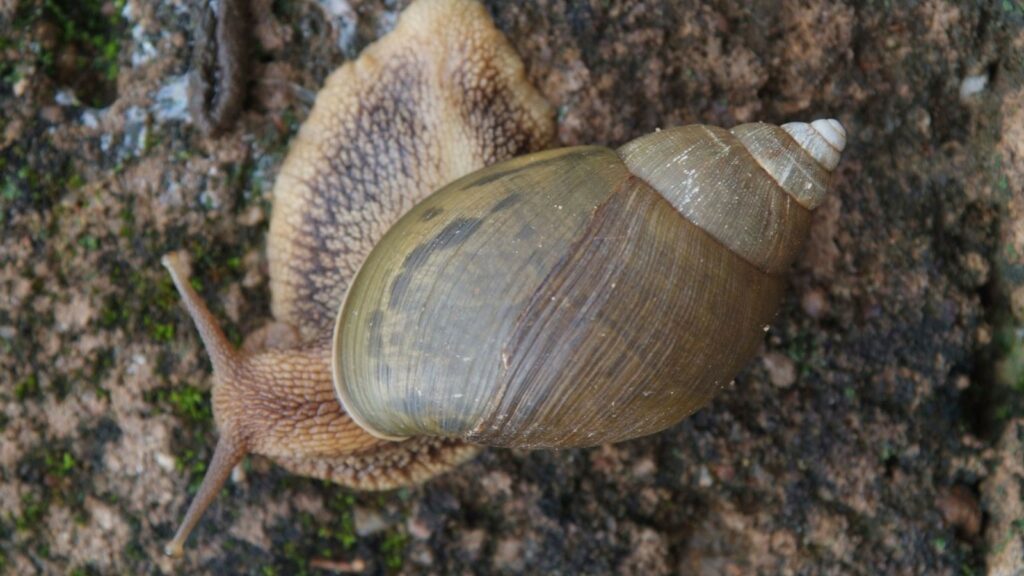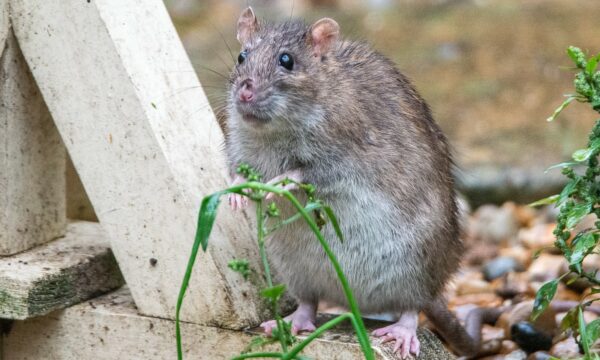Invasive snails are some of the most damaging invasive species in the world. In invaded regions, they pose a threat to the environment, the economy, and in some cases, human health.
Find out more about four of these invasive snails, including their native region, how they became established in invaded areas and the threat they pose.
Giant African land snail
Achatina fulica

The giant African land snail is a fast-growing polyphagous plant pest that has been introduced from its native range in East Africa to many parts of the world as a commercial food source (for humans, fish and livestock) and as a novelty pet.
Giant African land snails successfully invaded tropical regions with similar climatic conditions to their native range in East Africa. However, it is now found in temperate landscapes such as Japan and Argentina.
A. fulica has an extremely wide-ranging diet. It prefers decayed vegetation and animal matter, lichens, algae and fungi. However, it has been recorded on a large number of plants including most ornamentals, and vegetables.
The World Conservation Union, IUCN (ISSG, 2003) classified the Giant African land snail as one of the world’s top 100 invasive alien species.
Find out more about the giant African land snail on the Invasive Species Compendium
Rosy predator snail
Euglandina rosea

Native to the southeastern USA, rosy predator snails are carnivorous land snails that prey on other snails. It was first introduced to the Hawaiian Islands and subsequently introduced to a number of Pacific Islands in an attempt to control the spread of the introduced herbivorous snail Achatina fulica. Unfortunately, the rosy predator snails proved ineffective as a biocontrol and instead decimated native snail populations.
The rosy predator snail is responsible for the dramatic decline or eradication of many endemic species, particularly Partulidae and Achatinellinae. On the Society Islands, French Polynesia, only five of the original 61 species remain.
Find out about the rosy predator snail on the Invasive Species Compendium
Golden apple snail
Pomacea canaliculata

The Golden apple snail is a freshwater snail native to parts of Argentina and Uruguay. The distribution of P.canaliculata has been steadily increasing since its introduction to Asia, primarily for human consumption but perhaps also by the aquarium trade, beginning around 1979 or 1980.
Once introduced to an area, it spreads rapidly through bodies of water such as canals and rivers and during floods. It feeds on aquatic plants and can devastate rice (in Southeast Asia), taro (in Hawaii) and other aquatic or semi-aquatic crops.
Find out about the Golden apple snail on the Invasive Species Compendium
Assassin snail
Clea helena

Clea helena is a Southeast Asian freshwater snail closely related to the marine whelks (family Buccinidae). Though not reported in the literature as an invasive species, it is potentially a threat in warmer regions for a number of reasons.
Firstly, it is widely traded as an aquarium animal and can be commonly found in aquarium shops in North America, Europe and Asia already, and will likely be regularly traded elsewhere in due course.
Secondly, unlike some other freshwater invertebrates traded as aquarium animals, such as the shrimp Caridina multidentata and the snail Neritina coromandeliana, its life cycle does not include a marine stage, so it is able to reproduce under aquarium conditions.
Finally, under aquarium conditions at least, it will readily consume small aquatic snail species that it would not encounter in its natural habitat. As such, there is no reason to suppose it would be any less predatory if introduced populations became established outside the species’ natural range.
Find out about the assassin snail on the Invasive Species Compendium
Find out more about invasive snails and other invasive species on the Invasive Species Compendium
4 Comments
Leave a Reply
Related News & Blogs
5 invasive species to look out for in the US
The presence of invasive species poses a significant hazard to many native environments and species found in the United States (US). They lead to significant expenses in agriculture, forestry, and recreation. Once out of control, they can destroy entir…
26 February 2024





Thanks for the nice blog. Please correct the common name and scientific name. It should be:
Invasive (Golden) apple snail
Pomacea canaliculata
Hello, many thanks for your comment. We have corrected the small typo that was in the species name. As for the common name, we are mirroring what is on the CABI Invasive Species Compendium datasheet: Pomacea canaliculata
Thanks Donna. May I know your active email address. I sent you a while ago on but it bounced back. Ravi Joshi, email: rcjoshi4@gmail.com
Thanks, Ravi. I have sent you an email 🙂